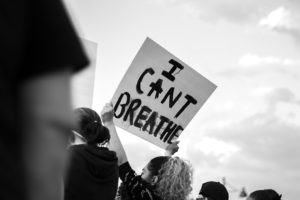George Floyd’s Last Hour
 Photo by Cooper Baumgartner on Unsplash
Photo by Cooper Baumgartner on Unsplash Is the newly seen bodycam video of George Floyd’s arrest and death a litmus test for white folks? Some are seeing the longer footage of what played out on May 25—footage that was leaked to the Daily Mail and published by the British tabloid Monday—and saying, “oh, we didn’t have the full picture before. Now it’s not such a cut-and-dry case of murder.” Or they say, “clearly race wasn’t an issue here; Floyd was erratic and out of control, under the influence of something.” They may still say his death was abhorrent but argue the new footage exonerates the Minneapolis police officers charged in his death.
Others see in the footage a man traumatized. A man utterly afraid of dying and pleading not to be killed. A Black man with a cop’s gun at his head having a full-blown panic attack and begging for help. That his fear runs on the fact that he’s a Black man facing a cop with a gun is what’s salient to this camp, not whether drugs are manifesting that fear in a highly agitated manner. It’s how I see it. I see George Floyd feeling under threat but threatening no one. I see a person in the last hour of his life who needs a professional trained to assist individuals in states of panic—not someone pointing a gun and asking why he’s acting “squirrely.”
Incidentally, last month a judge in Hennepin County, Minnesota, authorized journalists and the public to view the bodycam footage by appointment, and outlets such as NPR had reported on what they saw. But as it was when the public saw video of Officer Derek Chauvin kneeling on Floyd’s neck for eight minutes and forty-six seconds, the footage from body cameras worn at the scene by Officers Thomas Lane and J. Alexander Keung have elicited frank opinions about what people are seeing.
Some feel we shouldn’t participate in debates on whether Floyd was high or even if an unarmed Black man surrounded by four police officers is scary or threatening. But it should be undeniable that it’s the job of law enforcement to protect citizens and apprehend potential suspects—not to decide who gets to die on any particular day. No one should have to decide whether the risk of calling the police is worth the potential reward.
Someone I was discussing this with recalled a memory of a time her family suspected that an eccentric alcoholic uncle was in a diabetic coma in his apartment. He lived too far away (in a different state) for anyone they knew to check on him. He was a recluse and very secretive, so they didn’t know of any friends or neighbors he may have had. They tried calling the leasing office of his apartment building for two days with no answer. They thought about calling the police, but the uncle was a tall, Black man who, again, was an eccentric and abused alcohol. They were terrified that if he was alive and well, by the time the police left he wouldn’t be. When the leasing manager finally got around to check on him, he was dead. Maybe if her uncle had been found earlier he could’ve lived, this person remarked, but the family simply couldn’t trust calling the police on a Black man.
In June the US House of Representatives passed the George Floyd Justice in Policing Act with no chance of it being voted on in the Senate. It’s time for more cities and states to act: ban police use of chokeholds. Ban no-knock warrants in suspected drug cases. Promote de-escalation techniques. Embrace specific reforms like those laid out by the #8CantWait campaign.
For those seeing the leaked bodycam footage of Floyd’s arrest as a rationalization for the decisions made by those four Minneapolis police officers on May 25, thinking that if only George Floyd had acted differently instead of the officers acting differently, please think again. He wasn’t threatening them. He was scared and panicked. He couldn’t breathe. He should not have died under another person’s knee. We can skip the test and agree on that, right?
Now is not the time for a litmus test for white folks. It’s time to act to save Black lives.
